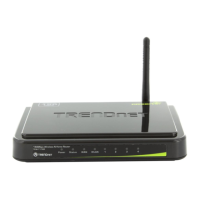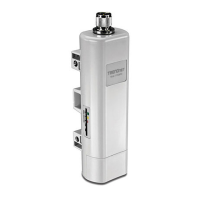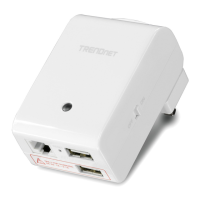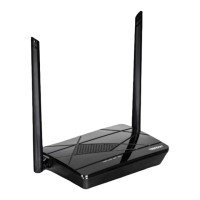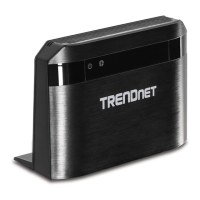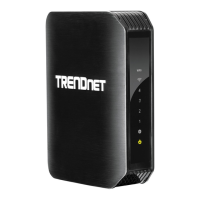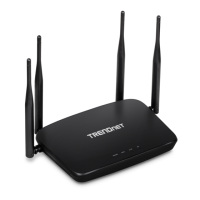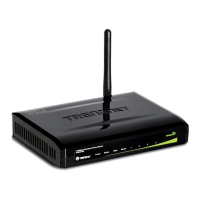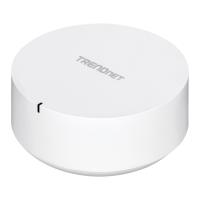© Copyright 2013 TRENDnet. All Rights Reserved.
TRENDnet User’s Guide
TEW-718BRM
63
Technical Specifications
Hardware
Standards
IEEE 802.3, IEEE 802.3u, IEEE 802.1Q, IEEE 802.1p, IEEE 802.11b, IEEE
802.11g, based on IEEE 802.11n technology
Complies with ADSL standards:
-ANSI T1.413 Issue2, G.992.1 (G.dmt, Annex A), G.992.2 (G.lite)
Complies with ADSL2 standard: G.992.3 (G.dmt.bis, Annex L)
Complies with ADSL2+ standard: G.992.5 (G.dmt.bis+, Annex M)
WAN (ADSL Line Interface) 1 x RJ-11 port (telephone)
LAN
4 x 10/100 Mbps Auto-MDIX RJ-45 ports (option to convert port 1 to WAN
port)
Reset / WPS / WLAN On & Off
Button
Reset: Reset to factory defaults (Hold for 15 sec.)
WPS: Activates Wi-Fi Protected Setup (WPS) (Hold for 3 sec.)
WLAN On / Off: Enables or disables wireless radio (Hold for 10 sec.)
ATM & PPP Protocols / Modes
VC and LLC multiplexing (Up to 8 PVCs), Ethernet over ATM (RFC 1483
Bridged) with NAT, RFC 1483 bridged, IP over ATM (RFC 1483 Routed), PPP
over ATM (RFC2364), PPP over Ethernet (RFC2516), ATM Traffic QoS (UBR,
CBR, VBR, GFR)
Firewall
NAT, SPI, DMZ host, virtual servers, MAC / IP filters, URL / keyword filters,
deny WAN ping requests, and WAN stealth mode
Schedules Define schedules for wireless, virtual server, packet filters, and QoS
Network Protocols/Features
IGMP v1/2/3 proxy and snooping , Static and dynamic routing RIP v1/2,
UPnP, DHCP (Dynamic Host Configuration Protocol) server/relay, Dynamic
DNS (DynDNS.com, No-IP.com, TZO.com, and dhs.org), NTP (Network Time
Protocol), PPTP / L2TP / IPsec VPN pass through, IPv6: Static, DHCPv6,
PPPoE, 6 to 4, and IPv6 in IPv4 Tunnel, Stateful / Stateless auto-
configuration
Quality of Service
Smart-QoS (simple) or manually defined QoS ToS / CoS (Type of service /
Class of service) based on IP, TCP/UDP port, MAC, DSCP (Differentiated
Services Code Point), and WMM
Management / Monitoring
Local / remote configuration, upgrade firmware, backup / restore
configuration via web browser, TR-069 remote management, DoS (Denial of
Service) detection, internal system log, Syslog, email alert, SNMP v1/v2c,
ping test tool, and Wake-on-LAN (WoL), NAT Status log, Client List log, Web
log, Modem log
LED Indicators Status, ADSL, WLAN, LAN1~LAN4
Power Adapter Input: 100~240V AC, 50~60Hz, 0.2A
Power Consumption 5 watts (max)
Dimension (L x W x H) 189 x 118 x 33 mm (7.4 x 4.6 x 1.3 in.)
Weight 221.1 g (7.8 oz)
Temperature
Operation: 0° ~ 40°C (32°F ~ 104°F)
Storage: -10° ~ 70°C (14°F ~ 158°F)
Humidity Max. 95% (non-condensing)
Certifications CE, FCC
Wireless
Frequency 2.4 ~2.483GHz band
Modulation DBPSK / DQPSK / CCK / OFDM (BPSK / QPSK / 16-QAM / 64-QAM)
Modes
Access Point Router, Access Point Only, WDS Hybrid, WDS Only, Universal
Repeater
SSID
Broadcast up to 2 SSIDs each with different wireless encryption with support
for VLAN mapping
Antenna 1 x 2 dBi detachable dipole antenna
Data Rate
802.11b: up to 11 Mbps
802.11g: up to 54 Mbps
802.11n: up to 150 Mbps
Security
WEP (HEX/ASCII): 64/128-bit
WPA (AES/TKIP): WPA / WPA2-RADIUS, WPA-PSK / WPA2-PSK
Output Power
802.11b: 17 dBm (typical)
802.11g: 14 dBm (typical)
802.11n: 14 dBm (typical)
Receiving Sensitivity
802.11b: -91 dBm (typical) @ 11 Mbps
802.11g: -91 dBm (typical) @ 54 Mbps
802.11n: -87 dBm (typical) @ 150 Mbps
Channels 1~ 11 (FCC), 1~13 (ETSI)
*Maximum wireless signal rates are referenced from IEEE 802.11 theoretical specifications. Actual
data throughput and coverage will vary depending on interference, network traffic, building
materials and other conditions.

